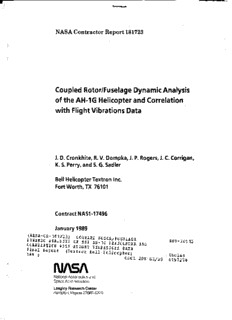
Coupled Rotor/Fuselage Dynamic Analysis of the AH-1G Helicopter PDF
Preview Coupled Rotor/Fuselage Dynamic Analysis of the AH-1G Helicopter
https://ntrs.nasa.gov/search.jsp?R=19890011141 2019-03-28T04:15:50+00:00Z NASA Contractor Report 181723 Coupled Rotor/Fuselage Dynamic Analysis of the AH-1G Helicopter and Correlation with Flight Vibrations Data J. D. Cronkhite, R. V. Dompka, J. P. Rogers, J. C. Corrigan, K. S. Perry, and S. G. Sadler Bell Helicopter Textron Inc. Fort Worth, TX 76101 Contract NASI-17496 _169-2 C5 12 N/ A National Aeronautics and Space Administration Langley Research Center Hampton, Virginia 23665-5225 FOREWORD Bell Helicopter Textron Inc. (BHTI) has been conducting a study of finite element modeling of helicopter airframes to predict vibration. This work is being performed under U.S, Government Contract NAS1-17496. The contract is monitored by the NASA Langley Research Center, Structures Directorate. This report summarizes the procedure used at BHTI for predicting coupled rotor/fuselage vibrations with an application to the AH-1G two-bladed rotorcraft including comparisons with flight test vibrations. Key NASA and BHTI personnel are listed below: NASA Lanqley Bell Helicopter Textron Inc. Panice H. Clark, Contracting Officer W. Young, Manager, Research Joseph W. Owens, Contract Specialist J. D. Cronkhite, Group Engineer, Structural Dynamics John H. Cline, Technical Representative R. V. Dompka, Senior Research Engineer Raymond G. Kvaternik, Leader, Rotorcraft Structural Dynamics Group G. Sadler, Chief, Rotor Dynamics J. Corrigan, Rotor Dynamics Group Engineer J. Rogers, Rotor Dynamics Engineer K. S. Perry, Rotor Dynamics Engineer .t.t .L._£ f .8 8 (9 SlTI eeeeeoeoeoooooeoeoeooeeeoeoooeee_o 533N3B333B "9 (9 6El oegoeoeeoeoeoeeooooeoeeoeeeeeeeloo SNOISQ7_N03 "5 n S6 ......................... SNOIIV73_OD NOIIV_81A 1H9173 o LS • " WV_90_d IS31 IH917_ (SIO) A3A_nS OV07 ]VNOIIV_3dO 91-HV 3H± 01 NOIIVDITddV S .................. OOHI3N 9NlTdnOD 39V73sn3/_OIO_ _0 NOIIdI_3S30 .I eoooeeoleeeoeeeoooeeeoeoeoeeooeeoe NOIIDNQO_INI "I .L eooooeeeoeeoeoeoeoeoeeooe_eoeeo_oeoo pJ0_aJo3 uo._,_as SIN31NOD 30 378Vl .... T ............................ O_ I NOIJ._nI30_IJ.NI "I. ¢M INTRODUCTION The NASA Langley Research Center is sponsoring a rotorcraft structural dynamics program with the overall objective to establish in the United States a superior capability to utilize finite element analysis models for calculations to support industrial design of helicopter airframe structures. Viewed as a whole, the program is planned to include efforts by NASA, universities, and the U.S. helicopter industry. In the initial phase of the program, teams from the major U.S. manufacturers of helicopter airframes will apply extant finite element analysis methods to calculate static internal loads and vibrations of helicopter airframes of both metal and com- posite construction, conduct laboratory measurements of the structural behavior of these air- frames, and perform correlations between analysis and measurements to build up a basis upon which to evaluate the results of the applications. To maintain the necessary scientific observation and control, emphasis throughout these activities will be on advance planning, documentation of methods and procedures, and thorough discussion of results and experiences, all with industry- o wide critique to allow maximum technology transfer between companies. The finite element models formed in this phase will then serve as the basis for the development, application, and 2 evaluation of both improved modeling techniques and advanced analytical and computational techniques, all aimed at strengthening and enhancing the technology base which supports industrial design of helicopter airframe structures. Here again, procedures for mutual critique o have been established, and these procedures call for a thorough discussion among the program participants of each method prior to the applications and of the results and experiences after the applications. The aforementioned rotorcraft structural dynamics program has been given the acronym DAMVIBS (Design Analysis Methods for VIBrationS). Under the DAMVlBS program, the four industry participants (BHTI, Boeing Helicopters, McDonnell- o Douglas Helicopter, and Sikorsky Aircraft) are to apply existing company methods for coupled *vl rotor-fuselage analysis to calculate vibrations of the AH-IG helicopter and to correlate with i-= data available from an Operational Load Survey (OLS) flight test program (References i and 2). In support of this common activity, BHTI, the manufacturer of the subject aircraft, was tasked to Fq o prepare and provide to the other participants the data needed to independently make these analyses and correlations. Specifically, BHTI was tasked to: i. Present a detailed description of the modeling rationale and techniques ased to develop the AH-IG NASTRAN fuselage finite element vibration model under a previous contract (Reference 3). A NASTRAN data deck of this model was provided to the other participating manufacturers. e Present a detailed description of all previous correlation work used to verify the finite element model (two versions - stick and built-up tailboom), including the following: .._.. MENTIONALL@yL_._ Ground vibration tests (GVT), static deflection tests and in-flight excitation a. simulation (References 4 and 5). Application of the built-up tailboom model predictions to the static _;*,dground b. vibration tests of Reference 4. Correlation of both models with other prior AH-IG results contained in References Co 6 and 7. Describe the OLS flight test program on the AH-IG and assemble the vibration data to be . used in the correlations. Present the AH-IG rotor system mechanical and aerodynamic coefficient data to all . participants. References i-7 were used to develop the necessary background on the FEM and flight loads data for the current rotor/fuselage coupling analysis task as summarized in References 8 and 9. This report describes work conducted by BHTI to evaluate the adequacy of current theoretical methods for predicting coupled rotor/fuselage vibration. The analysis methods described herein represent BHTI's advanced analysis rotorcraft flight simulation computer program C81 (Reference 10) and the industry's primary structural analysis computer program NASTRAN. These analytical methods form the basis of an approach to helicopter dynamic analysis that has been used successfully at BHTI for many years. This report describes the analytical formulation of rotor dynamic equations, fuselage dynamic equations, coupling between the rotor and fuselage, and solutions to the total system. The coupled analysis is applied to an AH-1G two-bladed rotor system and results compared with measured OLS flight test vibrations.
Description: